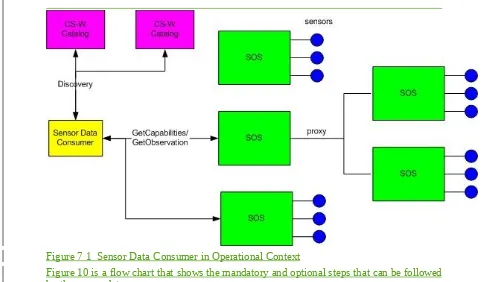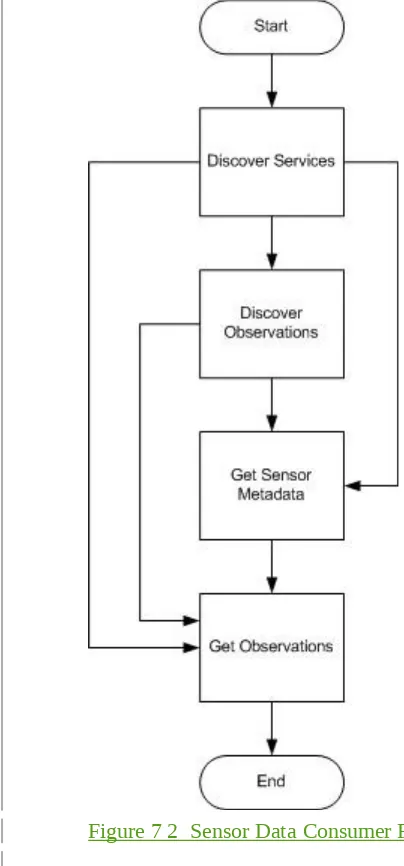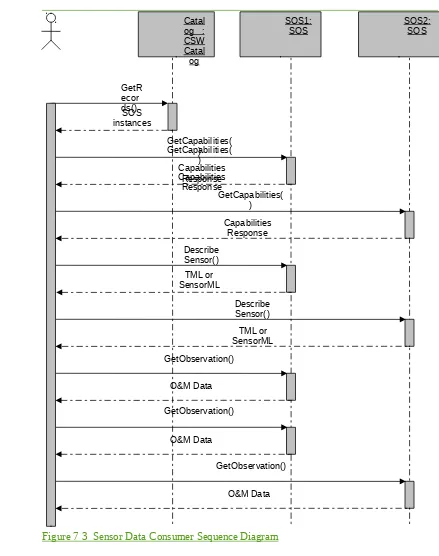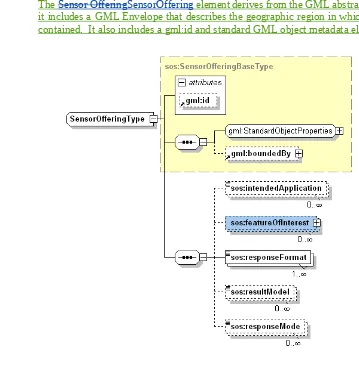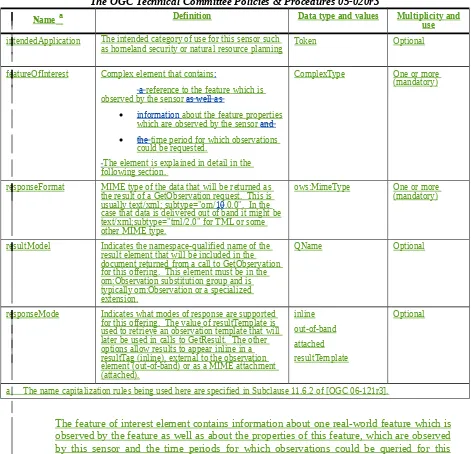Open Geospatial Consortium
OGC Doc
06-112
08-174
CR-Form-v3
CHANGE REQUEST
SOS CR
08-174?
rev-
Current version: 1.0.0 For
HELP
on using this form, see bottom of this page or look at the pop-up text over the symbols.
Proposed change affects: AS Imp Spec X Best Practices Paper Other
Title: SensorOfferings instead of ObservationOffering in GetCapabilities response
Source: Institute for Geoinformatics, University of Muenster
Work item code: Date: 2008-10-301-05
Category: C
Use one of the following categories: F (Critical correction)
A (corresponds to a correction in an earlier release)
B (Addition of feature),
C (Functional modification of feature) D (Editorial modification)
Detailed explanations of the above categories can be found in the TC Policies and Procedures.
Reason for change: Currently, no relationships between sensor, featureOfInterest and
observedProperties could can be expressed in the cContexnt section of the SOS Capabilities document.
Summary of change: Instead of grouping the offered observations into ObservationOfferings, we propose to create a SensorOffering for each sensor which contains the observed featureOfInterests as well as the observedProperties of each featureOfInterest. Additionally, the time period,shall be published for which observations produced by the sensor are available ., should be contained in the SensorOffering.
Consequences if
not approved: 1. No The and observedPropertiesrelationship could be expressed .cannot be expressed in current specification. between sensor, featureOfInterest This could lead to inconsistent queries of clients to the SOS.
2. ??
Clauses affected: 4.4 Observation Offering , 6.3 Observation Offerings , 7.2.1 Introduction
7.3.4 Publishing of observations 8.2.3.2 Contents Section
8.4.5.1 Simple Example Annex C.3
Other specs Other core specifications
Affected: Abstract specifications
Supporting Doc.
Other comments:
Status
Disposition
Edit Subclause 4.4 as follows:
4.4 SensorObservation Offering
An sensorobservation offering is a logical grouping of observations offered by a service that are related in some way. provides information about observations produced by a specific sensor or sensor system. The parameters that constrain the offering should be defined in such as way that the offering is “dense” in the sense that requests for observations that are within the specified parameters should be unlikely to result in an empty set.The sensor offeringSensorOffering comprises :
of the ID of the sensor (system)
, of the real-world features which are observed by the sensor
, of the time period(s) for which observations could be obtained for these features
and
of the properties of the observed features for which the sensor is producing values.
Edit Subclause 6.3 as follows:
6.3 Sensor OfferingSensorOfferings
A SOS provides information about the registered sensors in its service description by listing a collection of Sensor OfferingSensorOfferings in the Contents section of the Capabilities document (see section 8.3.2.3). One Sensor OfferingSensorOffering is created per sensor or sensor system. Each Sensor OfferingSensorOffering is constrained by a number of parameters including the following:
ID of the sensor (system) ; this could be also used to retrieve more detailed information by executing the DescribeSensor operation,
Geographical region that contains the sensors,
Time period(s) for which observations may be requested (supports historical data),
references to the real-world features that are the subject of the sensor observations (may differ from the sensor region for remote sensors),
SensorML description of the sensor is passed, the SOS creates a Sensor OfferingSensorOffering out of this description by parsing the ID of the sensor and the phenomena which are observed by the sensor. These phenomena usually depict the observed properties of the features of interest. It may be possible that the sensor is not observing a certain real-world feature when it is registered at the SOS. Thus the features of interest are extracted from later InsertObservation requests and should afterwards be listed in the Sensor OfferingSensorOffering.
Edit Subclause 7.2.1 as follows:
7.2.1 Introduction
A sensor data consumer is interested in obtaining sensor observations from one or more sensors. At a high level the consumer might approach this problem from either a sensor-centric or an observation-sensor-centric point of view. A sensor-sensor-centric point of view would be used if the consumer was already aware of the existence of particular sensors and wanted to find observations for those sensors. An observation-centric point of view would be used if the consumer wanted to see sensor data from a particular geographic area and that capture particular phenomena but is not aware of any particular sensors a-priori.
In either case the consumer would perform service discovery using service capabilities information, usually via a catalog service, in order to find SOS service instances that can provide the desired sensor observations. After initial discovery the consumer could directly obtain observations from services or could perform additional discovery at the service level or get sensor metadata before obtaining sensor observations. Service-level discovery involves invoking the GetCapabilities operation to return information about the offerings that are available from each service. Detailed sensor metadata can be obtained after extracting the sensor system identifiers out of each sensor offeringSensorOffering by invoking the DescribeSensor operation.
Figure 7 1 Sensor Data Consumer in Operational Context
Figure 7 2 Sensor Data Consumer Flow Chart
Edit Subclause 8.3.2.3 as follows:
8.3.2.3.Contents Section
The concept of a Sensor OfferingSensorOffering is discussed in section Error: Reference source not found above. It is a way to provide information for clients about the sensors which are providing observations using the SOS as well as about the features which are observed by the sensors and provide the geospatial information and about the feature properties (phenomena) for which the sensors are producing values.
The Sensor OfferingSensorOffering element derives from the GML abstract feature type so it includes a GML Envelope that describes the geographic region in which the sensors are contained. It also includes a gml:id and standard GML object metadata elements.
Figure Contents Section-1 Sensor OfferingSensorOffering
Figure 8-2 shows the structure of the Sensor OfferingSensorOfferingType. Besides the inherited properties of the GML abstract feature type, it could contain information about the intended application (e.g. disaster management, surveillance, etc.). The sensor could observe features, the so called featureOfInterest. The element could be omitted, if the sensor is already registered at the SOS, but is not yet observing a certain featureOfInterest.
Namea
Definition Data type and values Multiplicity anduse
intendedApplication The intended category of use for this sensor such
as homeland security or natural resource planning Token Optional
featureOfInterest Complex element that contains:
a reference to the feature which is observed by the sensor as well as
information about the feature properties which are observed by the sensor and
the time period for which observations could be requested.
The element is explained in detail in the following section.
ComplexType One or more (mandatory)
responseFormat MIME type of the data that will be returned as the result of a GetObservation request. This is usually text/xml; subtype="om/10.0.0". In the case that data is delivered out of band it might be text/xml;subtype="tml/2.0" for TML or some other MIME type.
ows:MimeType One or more (mandatory)
resultModel Indicates the namespace-qualified name of the result element that will be included in the document returned from a call to GetObservation for this offering. This element must be in the om:Observation substitution group and is typically om:Observation or a specialized extension.
QName Optional
responseMode Indicates what modes of response are supported for this offering. The value of resultTemplate is used to retrieve an observation template that will later be used in calls to GetResult. The other options allow results to appear inline in a resultTag (inline), external to the observation element (out-of-band) or as a MIME attachment (attached).
a The name capitalization rules being used here are specified in Subclause 11.6.2 of [OGC 06-121r3].
Figure Table 1 Sensor OfferingSensorOffering Elements-3 FeatureOfInterest
Table 3 FeatureOfInterest Elements
Namea
Definition Data type and values Multiplicity anduse
observationTime Time instant or Ttime period for which observations can be obtained. This supports the advertisement of historical as well as real-time observations.
gml:TimeGeometricPri
mitivePropertyType One (mandatory)
observedProperty The observable/phenomenon that can be requested in this sensor offeringSensorOffering. The observable has to be a property of the featureOfInterest. The sensor of the sensor offeringSensorOffering is providing time-dependent values (contained in the observations) for this property.
swe:PhenomenonProper
tyType One or more (mandatory)
